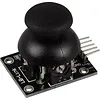
ESP32 USB-C WROOM 4Mb Devkit V1 Board with WiFi Bluetooth and Dual Core processor (OT1011)
The ESP32 development board with USB-C connection is the ideal choice for IoT (Internet Of Things) projects thanks to the built-in WiFi and Bluetooth functionalities. This board is easy to program via the Arduino IDE. For instructions on installing it in the Arduino IDE, watch the included YouTube video.
This model is also WLED compatible and can be quickly put to use using the OTRONIC ESP32 manual, designed specifically for the ESP32 Devkit V1 board.
Important: This ESP32 Devkit V1 model will not fit on a standard breadboard, unlike the ESP32-S, which is compatible with standard breadboards.
Features of this ESP32 board include:
- 18 Analog-to-Digital Converter (ADC) channels- 3 SPI interfaces- 3 UART interfaces- 2 I2C interfaces- 16 PWM output channels- 2 Digital-to-Analog Converters (DAC)- 2 I2S interfaces- 10 Capacitive sensing GPIOs
The ESP32 Wroom32 DevKit has a total of 25 GPIOs, some of which can only be used as input.
Power for the ESP32 DevKit V1 can be supplied via the built-in USB-C connector (5V) or directly via the "VIN" pin. The board works with an external power supply of 6 to 20 volts. Using more than 12V can cause the voltage regulator to overheat, which will shorten its lifespan. In such a case, it is recommended to use a STEP DOWN converter to lower the voltage.
Some GPIOs are for input use only and require an external pullup resistor if used as input pullup. An overview of the pins with and without internal pull up is available.
This board supports several WiFi communication methods:
- As a mini access point- As a WiFi client- As a web server- Peer-to-peer with ESP Now
ESP Now enables direct communication between modules via their MAC address, including feedback on the receipt of data for reliable message transfer.
Up to 20 ESP32 boards can communicate with each other via ESP Now, allowing for modular and rapid expansion of your project.
The board comes with header pins already soldered in, making it ready to use right away.
Programming the ESP32 in the Arduino IDE requires a few preparatory steps, including installing the Arduino IDE software, adding the ESP32 board manager URL, and selecting the correct board and COM port.
If the Arduino IDE includes RESOURCES -> PORT If there is no COM port available, the CH340C driver may need to be reinstalled. This is the USB chip on this board. Search Google or download the driver here:
Download CH340 driver for Windows
Download CH340 driver for Mac
Download CH340 driver for Linux
Board dimensions: - Length: 5.23cm - Width: 2.82cm - Height: 1.33cm
Mijn favoriet omdat hij korter is dan de meeste andere ESP32 bordjes.
Posted on 17/03/2025Werkt naar behoren.
Posted on 21/02/2025


















